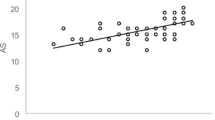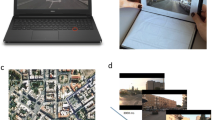Abstract
Field independence (FI) has been defined as the extent to which the individual perceives part of a field as discrete from the surrounding field, rather than embedded in the field. It has been proposed to represent a relatively stable pattern in individuals’ predisposition towards information processing. In the present study, we assessed the effect of FI on skills underpinning human navigation. Fifty Healthy individuals took part in this study. FI has been assessed by using the group embedded figures test (GEFT). Participants were also asked to perform several visuo-spatial orientation tasks, including the perspective taking/spatial orientation test (PTSOT), the mental rotation task (MRT) and the vividness task, as well as the Santa Barbara Sense of Direction Scale, a self-reported questionnaire, which has been found to predict environmental spatial orientation ability. We found that performances on the GEFT significantly predicted performances on the PTSOT and the MRT. This result supports the idea that FI predicts human navigation.



Similar content being viewed by others
References
Bednarek H, Truszczyński O, Wutke K (2013) Cognitive determinants of pilots’ effectiveness under a false horizon illusion. Int J Aviat Psychol 23(3):267–287
Bianchini F, Incoccia C, Palermo L, Piccardi L, Zompanti L, Sabatini U, Guariglia C (2010) Developmental topographical disorientation in a healthy subject. Neuropsychologia 48(6):1563–1573. doi:10.1016/j.neuropsychologia.2010.01.025
Bianchini F, Palermo L, Piccardi L, Incoccia C, Nemmi F, Sabatini U, Guariglia C (2014) Where am i? A new case of developmental topographical disorientation. J Neuropsychol 8(1):107–124. doi:10.1111/jnp.12007
Boccia M, Nemmi F, Guariglia C (2014) Neuropsychology of environmental navigation in humans: review and meta-analysis of FMRI studies in healthy participants. Neuropsychol Rev 24(2):236–251. doi:10.1007/s11065-014-9247-8
Coluccia E, Louse G (2004) Gender differences in spatial orientation: a review. J Environ Psychol 24:329–340
Ekstrom R, French J, Harman H, Dermen D (1976) Manual for kit of factor-referenced cognitive tests, vol 102. Educational Testing Service, Princeton, p 117. doi:10.1073/pnas.0506897102
Evans C, Richardson JTE, Waring M (2013) Field independence: reviewing the evidence. Br J Educ Psychol 83:210–224. doi:10.1111/bjep.12015
Ferlazzo F, Piccardi L, Burattini C, Barbalace M, Giannini AM, Bisegna F (2014) Effects of new light sources on task switching and mental rotation performance. J Environ Psychol 39:1–9. doi:10.1016/j.jenvp.2014.03.005
Fogliani Messina TM, Fogliani AM, Di Nuovo S (1984) Dipendenza dal campo e stile cognitivo: gli Embedded figures tests di H. Witkin, P. K. Oltman, E. Raskin e S. A. Karp. Organizzazioni speciali, Firenze
Guay R (1977) Purdue spatial visualization tests. Purdue Research Foundation, West Lafayette
Halpern DF (2000) Sex differences in cognitive abilities. Lawrence Erlbaum Assoc, Hillsdale
Hegarty M, Waller D (2004) A dissociation between mental rotation and perspective-taking spatial abilities. Intelligence 32:175–191. doi:10.1016/j.intell.2003.12.001
Hegarty M, Richardson AE, Montello DR, Lovelace K, Subbiah I (2002) Development of a self-report measure of environmental spatial ability. Intelligence 30:425–447. doi:10.1016/S0160-2896(02)00116-2
Iaria G, Bogod N, Fox CJ, Barton JJ (2009) Developmental topographical disorientation: case one. Neuropsychologia 47(1):30–40. doi:10.1016/j.neuropsychologia.2008.08.021
Janzen G, Jansen C, Van Turennout M (2008) Memory consolidation of landmarks in good navigators. Hippocampus 18:40–47. doi:10.1002/hipo.20364
Karp SA (1963) Field dependence and overcoming embeddedness. J Consult Psychol 27:294–302
Kozhevnikov M, Hegarty M (2001) A dissociation between object manipulation spatial ability and spatial orientation ability. Mem Cognit 29:745–756. doi:10.3758/BF03200477
Lawton CA (2010) Gender, spatial abilities and wayfinding. In: Chrisler JC, McGreary DR (eds) Handbook of gender research in psychology, vol. 1: gender research in general and experimental psychology. Springer, New York, pp 317–341
Mitolo M, Gardini S, Caffarra P, Ronconi L, Venneri A, Pazzaglia F (2015) Relationship between spatial ability, visuospatial working memory and self-assessed spatial orientation ability: a study in older adults. Cogn Process 16:165–176
Montello DR (1998) A new framework for understanding the acquisition of spatial knowledge in large-scale environments. In: Egenhofer MJ, Golledge RG (eds) Spatial and temporal reasoning in geographic information systems. Oxford University Press, New York
Navon D (1977) Forest before trees: the precedence of global features in visual perception. Cogn Psychol 9:353–383. doi:10.1016/0010-0285(77)90012-3
Nori R, Piccardi L (2011) Familiarity and spatial cognitive style: how important are they for spatial representation? In: Thomas JB (ed) Spatial memory: visuospatial processes, cognitive performance and developmental effects. Nova Publisher, New York, pp 103–124
Nori R, Piccardi L (2015) I believe I’m good at orienting myself… but is that true? Cogn Process 16:301–307
Nori R, Grandicelli S, Giusberti F (2006) Alignment effect: primary–secondary learning and cognitive styles. Perception 35:1233–1249
O’Keefe J, Nadel L (1979) The hippocampus as a cognitive map. Clarendon, Oxford
Oltman PK, Raskin E, Witkin HA (1971) Group embedded figures test. Consulting psychologists press, Palo Alto, CA
Palermo L, Nori R, Piccardi L, Zeri F, Babino A, Giusberti F, Guariglia C (2013) Refractive errors affect the vividness of visual mental images. PLoS ONE. doi:10.1371/journal.pone.0065161
Piccardi L, Bianchini F, Iasevoli L, Giannone G, Guariglia C (2011a) Sex differences in a landmark environmental re-orientation task only during the learning phase. Neurosci Lett 503(3):181–185. doi:10.1016/j.neulet.2011.08.031
Piccardi L, Risetti M, Nori R (2011b) Familiarity and environmental representations of a city: a self-report study. Psychol Rep 109:309–326. doi:10.2466/01.13.17.PR0.109.4.309-326
Piccardi L, Risetti M, Nori R, Tanzilli A, Bernardi L, Guariglia C (2011c) Perspective changing in primary and secondary learning: a gender difference study. Learn Individ Differ 21:114–118. doi:10.1016/j.lindif.2010.11.003
Poirel N, Pineau A, Jobard G, Mellet E (2008) Seeing the forest before the trees depends on individual field-dependency characteristics. Exp Psychol 55:328–333. doi:10.1027/1618-3169.55.5.328
Prestopnik JL, Roskos-Ewoldsen B (2000) The relations among wayfinding strategy use, sense of direction, sex familiarity and wayfinding ability. J Environ Psychol 20(2):177–191. http://dx.doi.org/10.1006/jevp.1999.0160
Price-Williams D (1988) Social/cultural anthropology: on the edge of the forest: cultural adaptation and cognitive development in Central Africa. JW Berry, JMH van de Koppel, C Sénéchal, RC Annis, S Bahuchet, LL Cavalli-Sforza, and HA Witkin. Am Anthropol 90:714–715. doi:10.1525/aa.1988.90.3.02a00430
Sholl MJ, Acacio JC, Makar RO, Leon C (2000) The relation of sex and sense of direction to spatial orientation in an unfamiliar environment. J Environ Psychol 20(1):17–28. http://dx.doi.org/10.1006/jevp.1999.0146
Siegel AW, White SH (1975) The development of spatial representations of large-scale environments, vol 10. Academic Press, Amsterdam
Takeuchi Y (1992) Sense of direction and its relationship with geographical orientation, personality traits and mental ability. Jpn J Educ Psychol 40:47–53
Verde P, Piccardi L, Bianchini F, Trivelloni P, Guariglia C, Tomao E (2013) Gender effects on mental rotation in pilots vs. nonpilots. Aviat Space Environ Med 84(7):726–729
Walter E, Dassonville P (2011) Activation in a frontoparietal cortical network underlies individual differences in the performance of an embedded figures task. PLoS ONE. doi:10.1371/journal.pone.0020742
Wegman J, Fonteijn HM, van Ekert J, Tyborowska A, Jansen C, Janzen G (2014) Gray and white matter correlates of navigational ability in humans. Hum Brain Mapp 35:2561–2572. doi:10.1002/hbm.22349
Willey CR, Jackson RE (2014) Visual field dependence as a navigational strategy. Atten Percept Psychophys 76(4):1036–1044. doi:10.3758/s13414-014-0639-x
Witkin HA (1967) A cognitive-style approach to cross-cultural research1. Int J Psychol 2:233–250. doi:10.1080/00207596708247220
Witkin HA (1977) Cognitive style in personal and cultural adaptation. Field-dependent and field-independent cognitive styles and their educational implications, vol 47. Clark university press, Worcester, MA, pp 1–64
Witkin HA, Oltman PK, Raskin E, Karp S (1971) A manual for the embedded figures test. Consulting psychologists press, Palo Alto, CA
Wolbers T, Hegarty M (2010) What determines our navigational abilities? Trends Cognit Sci 14:138–146. doi:10.1016/j.tics.2010.01.001
Author information
Authors and Affiliations
Corresponding author
Rights and permissions
About this article
Cite this article
Boccia, M., Piccardi, L., Di Marco, M. et al. Does field independence predict visuo-spatial abilities underpinning human navigation? Behavioural evidence. Exp Brain Res 234, 2799–2807 (2016). https://doi.org/10.1007/s00221-016-4682-9
Received:
Accepted:
Published:
Issue Date:
DOI: https://doi.org/10.1007/s00221-016-4682-9




